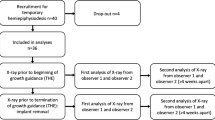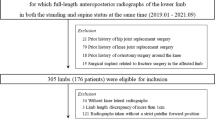Abstract
The purpose was to assess axial alignment of the lower limb using mechanical axis measurements on conventional and digital radiographs. Total-leg radiographs of 24 patients, 8 male and 16 female, with a mean age of 68.6±10.2 years, were performed in a standardized anterior-posterior projection and standing position using a conventional and digital phosphor storage film screen radiography system. Knee joint angulation was assessed by measuring the angle between a line drawn from the center of the femoral head to the middle of the femoral condyles and a line drawn from the middle of the tibial condyles to the midpoint of the malleolus. On conventional leg radiographs, line drawing and angle measurement were performed manually with a transparent goniometer. Angle measurement on digital leg radiographs was performed on a PACS workstation using computer-assisted measurement software (IMPAX, AGFA-GEVAERT, Belgium). Evaluation time for both measurements was recorded. We diagnosed 14 varus and 10 valgus angulations of the knee joint. The mean individual difference between axis deviation of conventional digital leg radiographs was 0.93+0.6°(min 0°, max 2°), the mean difference in varus angulation was 1.13±0.45° (min 0.3°, max 2°), and the mean difference in valgus angulation was 0.65±0.71° (min 0°, max 2°). Angle measurements on conventional and digital radiographs did not show any statistically significant difference. Mean time exposure was 4.9 min/patient for manual and 1.08 min/patient for computer-assisted angle measurement (P<0.001). Computer-assisted angle measurement on digital total-leg radiographs represents a reliable method with no significant angle differences compared to conventional radiographic systems and offers a significantly lower evaluation time.

Similar content being viewed by others
References
Moreland JR, Bassett LW, Hanker GJ (1987) Radiographic analysis of axial alignment of the lower extremity. J Bone Joint Surg 69A:745–749
Lotke PA, Ecker ML (1977) Influence of positioning of prosthesis in total knee replacement. J Bone Joint Surg 59A:77–79
Paley D, Tetsworth K (1992) Mechanical axis deviation of the lower limbs: preoperative planning of uniapicular deformities of the tibia or femur. Clin Orthop 280:48–64
Petersen TL, Engh GA (1988) Radiographic assessment of knee alignment after total knee arthroplasty. J Arthroplasty 3:67–72
Tetsworth K, Paley D (1994) Malalignment of degenerative arthropathy. Orthop Clin North Am 25:367–377
Shearman CM, Brandser EA, Kathol MH, Clark WA, Callaghan JJ (1998) An easy linear estimation of the mechanical axis on long-leg radiographs. Am J Roentgenol 170:1220–1222
Krackow KA, Pepe CL, Galloway EJ (1990) A mathematical analysis of the effect of flexion and rotation an apparent varus/valgus alignment an the knee. Orthopedics 13:861–868
Odenbring S, Berggren AM, Peil L (1993) Roentgenographic assessment of the hip-knee-ankle axis in medial gonarthrosis. A study of reproducibility. Clin Orthop 289:195–196
Sanfridsson J, Ryg L, Eklund K et al (1996) Angular configuration of the knee. Comparison of conventional measurements and the QUESTOR precision radiography system. Acta Radiol 37:633–638
Grampp S, Czerny C, Krestan C, Henk C, Heiner L, Imhof H (2003) Flachbilddetektorsysteme in der Skelettradiologie. Radiologe 43:362–366
Imhof H, Dirisamer A, Fischer H, Grampp S, Heiner L, Kaderk M, Krestan C, Kainberger F (2002) Rozessmanagementänderung durch den Einsatz von RIS. PACS und Festkörperdetektoren. Radiologe 42:344–350
James JJ, Davies AG, Cowen AR, O’Connor PJO (2001) Developments in digital radiography: an equipment update. Eur Radiol 11:2616–2626
May GA, Deer DD, Dackiewicz D (2000) Impact of digital radiography on clinical workflow. J Digit Imaging 13(Suppl 1):76–78
Eklund K, Jonsson K, Lindblom G, Lundin B, Sanfridsson J, Sloth M, Sivberg B (2004) Are digital images good enough? A comparative study of conventional film-screen versus digital radiographs on printed images of total hip replacement. Eur Radiol 14:865–869
Author information
Authors and Affiliations
Corresponding author
Rights and permissions
About this article
Cite this article
Sailer, J., Scharitzer, M., Peloschek, P. et al. Quantification of axial alignment of the lower extremity on conventional and digital total leg radiographs. Eur Radiol 15, 170–173 (2005). https://doi.org/10.1007/s00330-004-2436-8
Received:
Revised:
Accepted:
Published:
Issue Date:
DOI: https://doi.org/10.1007/s00330-004-2436-8




